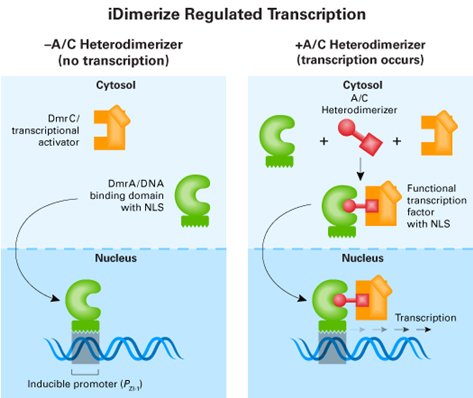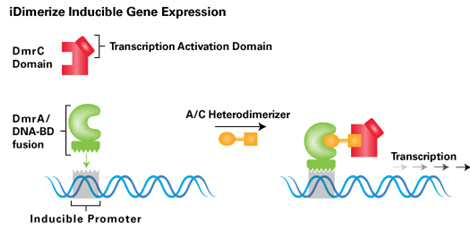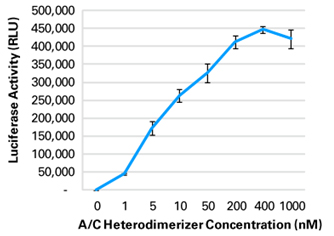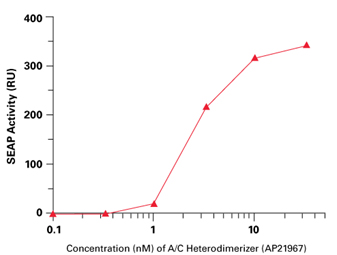1. transcription activation과 DNA binding components를 발현하는 플라스미드(pHet-Act1-2)
2. PZI-1 inducible promoter(in pZFHD1-2)의 하류에 클로닝된 목적유전자
DNA binding component는 promoter에 결합되어 있어 DmrA와 DmrC를 통해 전사활성요소들이 결합하여 전사가 활성화 될 때까지 전사를 억제한다. A/C Heterodimerizer가 첨가되면 두 components가 결합하고 PZI-1 promoter로부터 목적 유전자가 전사된다.

The iDimerize Regulated Transcription System uses the tight PZI-1 promoter, which exhibits very low background in the absence of induction because it is not recognized by host transcription factors. A further level of control is provided separating the DNA binding component (DmrA/DB; green) and transcription activation component (DmrC/TA; yellow) into separate compartments in the cell. DmrC/TA does not possess a nuclear localization signal (NLS), so it resides predominantly in the cytoplasm; however, it is brought to the nucleus by the addition of A/C heterodimerizer which causes its interaction with DmrA/DB. DmrA/DB does possess an NLS, so when A/C heterodimerizer is added, the transcription factor is completed through dimerization. The complete transcription factor is translocated into the nucleus, where it binds the PZI-1 promoter and induces expression of the gene of interest.

Tightly regulated transcription using iDimerize technology. Clone your gene of interest downstream of the ZHFD1 inducible promoter (PZI-1). The DNA binding component (DmrC/DNA-BD fusion; red) recognizes and binds sequences within the promoter. However, activation of transcription only occurs when the DmrC/DNA-BD dimerizes with the transcription activation component (DmrA-AD fusion; green) at the promoter, when the DmrA and DmrC domains both bind to the A/C Heterodimerizer (AP21967).

Regulated transcription of luciferase using the iDimerize Regulated Transcription System. Firefly luciferase was cloned into the multiple cloning site of the pZFHD1-2 vector. The plasmid was then cotransfected into HEK 293 cells with pHet-Act1-2 (which expresses the transcription activation components). Cells were treated with the indicated doses of A/C Heterodimerizer, and induced gene expression was measured 24 hr later. Induced expression of luciferase was measured using a luminometer. RLU = Relative Light Units.

Dose-dependent control of gene expression with the iDimerize Inducible Expression System. HT1080 cells were stably transfected with the secreted alkaline phosphatase (SEAP) reporter gene and the DmrC-AD/DmrA-DBD constructs, and treated with or without A/C Heterodimerizer. In the absence of A/C Heterodimerizer, target gene expression was undetectable. Half-maximal induction occurred at 2 nM A/C Heterodimerizer.